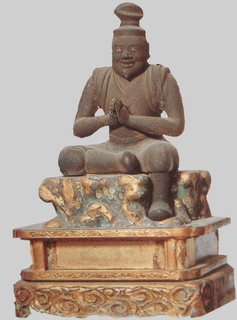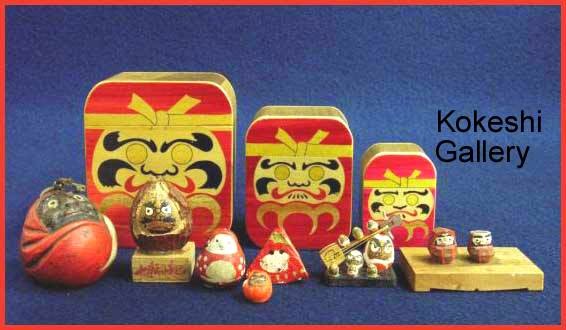:::::::::::::::::::::::::::::::::::::::::::::::::::::::::::::::::::::::::::::::::::::::::::::::::::::
Oasahiko and Hakuchoo Daruma Doll
This is a very special Daruma with the letter ASA on the belly, refering to a Shinto Deity. So our Daruma san can reincarnate in many forms !
I asked the young priest, why they had choosen a Daruma doll to represent Oasahiko. "Well, Daruma is a symbol of good luck and perseverance. Seven times down, you know.... , people like Daruma for a New Year token, so we choose to make one with the ASA mark on it. And it sells well, you know". Indeed, the Daruma dolls on the shelf came in six different sizes!
This Daruma Doll belongs to the Papermachee Dolls of Hakuchoo、Ehime Prefecture.
白鳥張子 (金谷達磨) 愛媛県。
http://www.darumanetjapan.com/da_text/d-sikok-new.html
Hakuchoo Papermachee Dolls were produced in Hakuchoo Village by Kanaya Kenjiroo 金谷健次郎. He also made lion's heads (shishigashira). After the World War, he also produced Daruma dolls which were sold at the Konpira Shrine. These Daruma had the Chinese character GOLD 金 on the belly, whereas the ones he produced for the Asahiko Shrine had the character HEMP 麻 or a circle with Gook Luck 福。
In some years they produced many ten thousands of these Daruma which were sold all over Western Japan. But when Master Kanaya became to old, the production became smaller and then was shut down.
This simple Daruma has now been revived and is sold in many sizes and with or without a headband.
But now let us go back to the Oasahiko Shrine.
:::::::::::::::::::::::::::::::::::::::::::::::::::::::::::::::::::::::::::::::::::::::::::::::::::::
The deity Oasahiko no Okami 大麻比古の大神、is enshrined in the Oasahiko Shrine in Naruto Town, Tokushima Prefecture, Shikoku. He protects the people from traffic accidents and evil and is affectionately called "Owasa-Han".
This shrine is the Number One Shrine of Awa, (Awa no Kuni Ichi no Miya) dedicated to the mythological first settler of this province, Oasahiko, who started growing asa (flax) and cotton. Its annual festival is held on November 1. The shrine was founded before 800 and got a high ranking of 5th grade in 866. It was awarded fields and a mountain with dense forest. Oasayama mountain is more than 530 m high.
Nowadays the shrine is supportetd by the Jinja Honchoo Headquarters of Shrines.
In the precincts, the huge camphor tree, kusu no ki, is most impressive.
(My Album Nr. 21 - 24).
The hemp leaf in Japanese family crests 麻の葉紋
http://www.genbu.net/sinmon/asa.htm
The pilgrims stamp of this shrine
http://www.genbu.net/data/awa2/ooasahiko_syuin.htm
The Lion-Dogs Koma-inu of this shrine
http://www.infoeddy.ne.jp/~jcinoko/naruto/ishoku1.htm
:::::::::::::::::::::::::::::::::::::::::::::::::::::::::::::::::::::::::::::::::::::::::::::::::::::
Other links and shrines dedicated to Ooasahiko
http://kamnavi.jp/en/sikoku/taimahi.htm
http://www.genbu.net/data/awa2/ooasahiko_title.htm
http://www2.tcn.ne.jp/~myoujin/html/
:::::::::::::::::::::::::::::::::::::::::::::::::::::::::::::::::::::::::::::::::::::::::::::::::::::
Look at . my album . with more photos from the shrine and its marvellous old trees.
Starting from Nr. 19 to Nr. 35.
Oasahiko Shrine PHOTOS
:::::::::::::::::::::::::::::::::::::::::::::::::::::::::::::::::::::::::::::::::::::::::::::::::::::
Doitsu - kan - German House and Museum
Deutsches Haus Naruto
During WW1 about 1000 German prisoners of war spent from 1917 on, three years in the prison camp of Bando. Due to the camp's commanding officer's humanitarian administration they came into contact with the region's people, teaching aspects of German culture and skills like baking bread, growing vegetables, raising cattle etc. Along the more than 100 concerts performed by the prisoners' orchestras was also the very first performance of Ludwig van Beethoven's“Symphony No.9”in Japan.
In order to memorize the German prisoners' activities the first“German House”opened in 1972. The new German House opened in October 1993.
http://www.ritsumei.ac.jp/mng/er/wp-museum/pmlinks/pm10.htm
It is located next to Osashiko - jinja and houses the photographs, newspapers, magazines, tools and other mementoes of the 953 German prisoners of the First World War, who stayed here for 3 years from 1917. "The German Bridge" built by them is still there behind Oasahiko - jinja.
They also showed local people how to make cheese and butter from milk, while introducing cabbage, tomatoes and onions.
:::::::::::::::::::::::::::::::::::::::::::::::::::::::::::::::::::::::::::::::::::::::::::::::::::::
Von Toshiaki Kamei, Oberbürgermeister der Stadt Naruto Das Deutsche Haus unserer Stadt wurde auf dem Hintergrund eines freundschaftlichen Kulturaustausches der hiesigen Bevölkerung mit deutschen Kriegsgefangenen, der sich um das Kriegsgefangenenlager Bando während des Ersten Weltkrieges rankt, der darauffolgenden, geerbten Hinterlassenschaften jener deutschen Soldaten als auch zur Förderung der Erziehung erbaut. Auf dieser Grundlage aufbauend, setzen wir uns für den internationalen Kulturaustausch ein. Dieser Kulturaustausch beinhaltet den Austausch mit der Partnerstadt Lüneburg, das Auffinden von Unterlagen der ehemaligen deutschen Kriegsgefangenen über deren Nachkommen, sowie die Herausgabe der Lagerzeitung " Die Baracke " der damaligen Kriegsgefangenen in deutscher und japanischer Version. Wenn man sagt "Japan und Deutschland haben gegeneinander gekämpft", so werden wohl viele darüber überrascht sein. Was die Beziehungen Japans zu Deutschland betrifft, so erhielt Japan doch schließlich Hilfe bei der Erschaffung einer Verfassung und blickte zu den Anleitungen im Heereswesen auf. Zudem waren während des Zweiten Weltkrieges beide Länder zusammen mit Italien Verbündete. Aber es gab auch eine Zeit, in der beide Länder sich bekämpften. Es war im Jahre 1914 (3. Jahr der Taisho-Ära) mit dem Ausbruch des Ersten Weltkrieges, der Schauplatz war die Stadt Tsingtao auf der chinesischen Halbinsel Shangtung.Zu jener Zeit war Japan mit England verbündet, und England bat um Beistand zum Schutz seiner Schiffe. Bei dieser Gelegenheit schickte Japan 30.000 Soldaten nach Tsingtao, wo sich der deutsche Stützpunkt befand. Auf Seiten der sich verteidigenden Deutschen waren es insgesamt nur 5.000 Soldaten, und nach ungefähr drei Monaten standen Sieger und Besiegte fest.Nach dem Ende der Kampfhandlungen kamen ca. 4.700 deutsche Soldaten als Kriegsgefangene nach Japan und wurden an zwölf verschiedenen Orten untergebracht. Aber da es sich hauptsächlich dabei um Tempel und öffentliche Gebäuden handelte, war es um die Unterbringungsbedingungen nicht gut bestellt. Daher brachte man die Kriegsgefangenen später in sechs neu gebauten bzw. renovierten Lagern unter, wozu auch amerikanische Diplomaten rieten. So wurden auch die drei Lager Matsuyama, Marugame und Tokushima auf Shikoku zu dem Lager Bando im heutigen Stadtteil Oaza-cho von Naruto zusammengelegt. Dies war im April 1917 (6. Jahr der Taisho-Ära). Dort verbrachten rund Tausend deutsche Soldaten zwei Jahre und zehn Monate. Während dieser Zeit brachte man ihnen sowohl von Seiten der Lagerverwaltung, wie z.B. von dem Lagerkommandaten Oberst Toyohisa Matsue, als auch von Seiten der dortigen Bevölkerung, die sich mit den deutschen Soldaten anfreundete und diese mit "Herr Deutscher" anrief, Fürsorge entgegen. So galt das Lager Bando als ein Musterlager, und die Kriegsgefangenen führten dort ein vergleichsweise angenehmes Leben. http://www.city.naruto.tokushima.jp/germanhouse/ruhe/doitugo/no_1/ruhe1.html |
.....................................................................................
Link with some photos of the exhibits:
http://www.city.naruto.tokushima.jp/germanhouse/
(Japanese日本語)
http://www.amateras.com/trip/japan/naruto/naruto-e.htm
:::::::::::::::::::::::::::::::::::::::::::::::::::::::::::::::::::::::::::::::::::::::::::::::::::::
BACK TO
Shikoku Pilgrims 2005
:::::::::::::::::::::::::::::::::::::::::::::::::::::::::::::::::::::::::::::::::::::::::::::::::::::
Shinto and Hemp - 麻 asa 大麻 taima, oasa
Ame no Hiwashi no Mikoto 天日鷲命 アメノヒワシノミコト
ogara 苧殻 hemp reed, hemp string
麻幹/麻殻/あさぎ asagi
ogara 苧殻 (おがら) string made from hemp (to light the mukaebi)
..... asagara 麻殻(あさがら)、asagi あさぎ
ogarabi 苧殻火(おがらび)fire lit with hemp string and reeds
ogarabashi 苧殻箸 chopsticks from ogara hemp reeds
. 麻 asa 大麻 taima, oasa - Japanese hemp culture .
. Tengu 天狗と伝説 Tengu legends "Long-nosed Goblin" .
:::::::::::::::::::::::::::::::::::::::::::::::::::::::::::::::::::::::::::::::::::::::::::::::::::::
. WKD : Ludwig van Beethoven
. Folk Toys from Tokushima .
[ . BACK to WORLDKIGO TOP . ]
[ . BACK to DARUMA MUSEUM TOP . ]
:::::::::::::::::::::::::::::::::::::::::::::::::::::::::::::::::::::::::::::::::::::::::::::::::::::















































